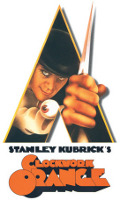
Directed by
Stanley Kubrick
131 minutes
Rated R
Reviewed by
Bernard Hemingway


Clockwork Orange, A
It is no accident that Kubrick’s film was released within weeks of Sam Peckinpah's Straw Dogs both films featuring high levels of violence including a rape scenes. Such were the temper of times.
In a classic case of a career peaking too early Malcolm McDowell in his most memorable screen role is marvellous as Alex DeLarge, a vicious little popinjay who lives in a council flat with his Ma and Pa (Sheila Raynor and Philip Stone) and indulges his passion for violence ("the old ultra-v"), sex ("the old in-out, in-out") and Beethoven ("the old Ludwig van") with the aid of his "droogs". When two of the latter, Dim (Warren Clarke) and Georgie (James Marcus) rebel against Alex’s authoritarian leadership of their gang he thrashes them. In retaliation they set him up and Alex is caught by the police and sentenced to 14 years in prison for murder. But Alex sees a way out and volunteers for an experimental brain-washing cure. It works and he is released but Alex finds his vicious past coming back to revenge itself on him.
Although violence and sex have become far more explicit and extensive in film today there still audiences who will have trouble with the content of A Clockwork Orange largely because it is treated with such perverse gleefulness Few however would dispute the mastery of Kubrick’s direction. From the opening shot, a slow zoom into Alex’s eyes that pulls back to reveal him and his droogs in the Korova milk bar, Kubrick carefully orchestrates each scene and builds them into a tightly controlled whole.
The resonance of A Clockwork Orange is to be found as much, if not more, in John Barry's retro-futuristic production design, the film shifting between, on the one hand, ultra-chic modernist design and its kitsch counterpoints, on the other,brutalist architecture and deserted public spaces.
Whilst part of the success of the film derives from Burgess’s novel with its memorable invented argot (its vocabulary derived largely from Russian) the retro-futuristic art direction and wardrobe and set design, aided by some well-chosen location photography create not just a convincing alternative universe for the action but keeps the film in an allegorical mode rather than the traditionally emotionally-invested violence seen in Peckinpah’s film. Not that this was so evident in its day particularly as Kubrick omitted the novel's rather weak final chapter leaving us with a much darker, but one feels,artistically more satisfactory, ending.
FYI: Burgess tried to stop the film’s release in the UK and after copy-cat crimes Kubrick withdrew it from British distribution and it remained unseen there theatrically until after his death. David Prowse, who plays the male nurse of the wheelchair-bound Patrick Magee would go onto a career high playing Darth Vader.
Want something different?





